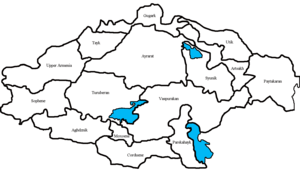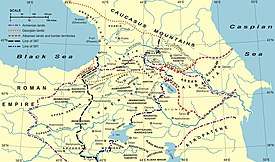Varsken
Varsken (Middle Persian: Vazgēn) was an Iranian prince from the Mihranid family of Gardman, who served as the viceroy of Gugark from 470 to 482. He was the son and successor of Arshusha II. Varsken was a highly regarded man among the Iranians, and played a leading role in the Sasanians effort to Zoroastrianize the Caucasus, which even made him murder his own wife Shushanik and attack Iberia, which resulted in his death at the hands of the troops of the Chosroid ruler Vakhtang I in 482.
| Varsken | |
|---|---|
| Viceroy of Gugark | |
| Reign | 470 – 482 |
| Predecessor | Arshusha II |
| Successor | Arshusha III |
| Died | 482 Iberia |
| Consort | Shushanik Unnamed Sasanian princess |
| Dynasty | Mihranids |
| Father | Arshusha II |
| Mother | Anushvram Artsruni |
| Religion | Christianity (5th-century–470) Zoroastrianism (470–482) |
Origins
Varsken belonged to the Mihranid family of Gardman. The family claimed Sasanian Persian descent, but were in reality a branch of the Parthian Mihranid family of Ray.[1][2] Although the family of Varsken originally practiced Zoroastrianism, it converted to Christianity during the family's service in the Caucasus.
Biography

Varsken's mother was Anushvram Artsruni, an Armenian noblewomen from the Artsruni family, who was the sister-in-law of the Armenian aristocrat Hmayeak Mamikonian, himself brother of the Armenian rebel and martyr Vardan Mamikonian. Varsken's father, Arshusha II, was a hostage of the Sasanian court at Ctesiphon, and could not participate in the Christian Armenian rebellion in 451, led by Vardan Mamikonian. After the defeat of the Armenian rebels at Avarayr, Hmayeak Mamikonian was killed at Tao. Hmayeak's sons, Vahan Mamikonian, Vasak, Vard and Artaxias, were then taken hostage and sent to Ctesiphon, where they met Arshusha II.[3][4]
Arshusha was later able to buy his freedom back. He then freed the sons of Hmayeak, and took them back to Armenia with their mother. Later, Arshusha organized the wedding of his son Varsken with Shushanik, daughter of Vardan Mamikonian.[5][6] Upon the death of his Arsusha, Varsken went to Ctesiphon with the Sasanian shah Peroz I, and converted to the family's former religion, Zoroastrianism. He shortly married a daughter of Peroz and was given the governorship of Caucasian Albania.[7] He later went back to Armenia, where he tried to force his first wife, Shushanik, to convert to Zoroastrianism, but the latter refused.
Varsken then threatened her to send her on a donkey to Ctesiphon, where she would get executed. Shushanik, however, once again refused, and eventually died from the violence inflicted by her husband.[5][8] Varsken later sought to conquer Iberia, and was given support by Peroz. In 482, Varsken invaded Iberia, but he was defeated and killed by its ruler Vakhtang I.[8][9]
References
- Bosworth 1986, pp. 520–522.
- Chamont 1985, pp. 806–810.
- Grousset 1947, pp. 193–202.
- Dédéyan 2007, pp. 189–190.
- Dédéyan 2007, p. 191.
- Grousset 1947, p. 213.
- Toumanoff 1963, p. 262.
- Grousset 1947, p. 216.
- Dédéyan 2007, p. 192.
Sources
- (in French) Les dynasties de la Caucasie chrétienne de l’Antiquité jusqu’au XIXe siècle ; Tables généalogiques et chronologiques, Rome, 1990.
- (in French) Histoire de l'Arménie: des origines à 1071, Paris, 1947.
- Continuité gentilice et continuité sénatoriale dans les familles sénatoriales romaines à l'époque impériale, 2000
- Chaumont, M. L. (1985). "ALBANIA". Encyclopaedia Iranica, Vol. I, Fasc. 8. pp. 806–810.CS1 maint: ref=harv (link)
- Bosworth, C. Edmund (1986). "ARRĀN". Encyclopaedia Iranica, Vol. II, Fasc. 5. C. Edmund Bosworth. pp. 520–522.CS1 maint: ref=harv (link)
- Toumanoff, Cyril (1963). Studies in Christian Caucasian history. Georgetown University Press. pp. 1–599.CS1 maint: ref=harv (link)
| Preceded by Arshusha II |
Mihranid Viceroy of Gugark 470-482 |
Succeeded by Arshusha III |
